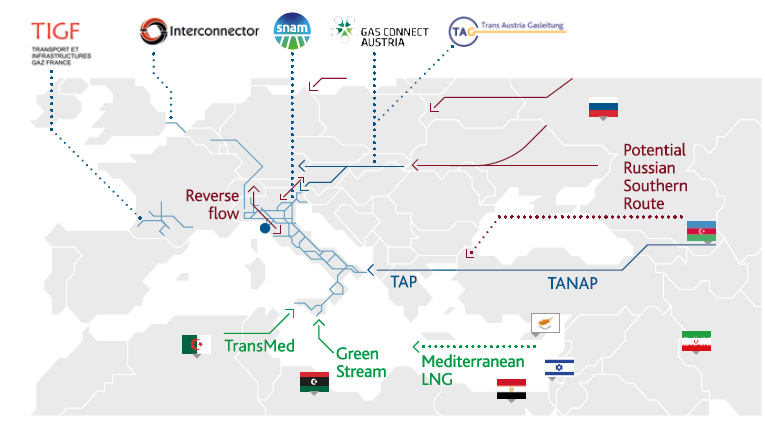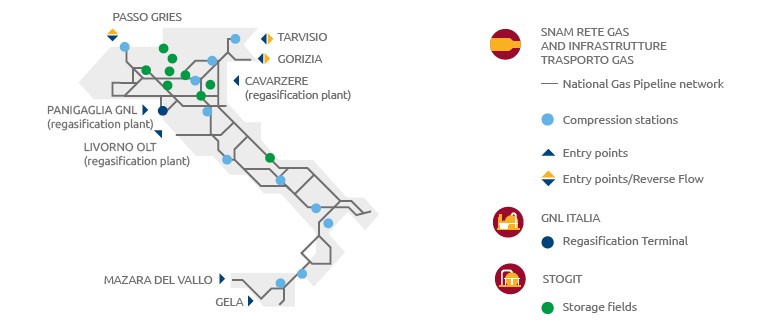Development of the gas system

To reinforce the central importance of the gas system in the European and Italian energy scenario, Snam will continue to invest to strengthen and expand the national network, which comprises the Sardinia methanisation project and the completion of the “reverse-flow” projects enabling its integration with the continental markets along the North-South and East-West corridors, creating a bi-directional flow of gas at the national borders at Passo Gries and Tarvisio respectively.
In 2020 the importation of natural gas from the Caspian Basin is also projected through the construction of the TAP natural gas pipeline, the terminal pipeline of the project for the so-called Southern Gas Corridor, one of the strategic priorities for the European Union.
Together with the institutional stakeholders and other interested operators, Snam will also continue to develop projects related to the evolution of the gas product (LNG and CNG) in the transportation sector and in biomethane production.
The natural gas introduced into the national network comes from imports and, to a lesser extent, national production. The foreign gas is injected into the national network through eight entry points where the network joins up with the import pipelines (Tarvisio, Gorizia, Gries Pass, Mazara del Vallo and Gela) and with the LNG regasification terminals (Panigaglia, Cavarzere and Livorno).
Domestically produced gas is injected in the network through 53 entry points from the production fields or their collection and treatment centres; gas storage fields are also connected to the network.
The Dispatching Center manages the gas flows through the national transportation network: from the control room, manned 24/7, the main gas pipelines and compression installations of the Italian gas system are monitored and remotely-controlled; operators are also provided with an overall view of the national gas transportation network with the main points of interest and related process information. The Dispatching Center coordinates the activities carried out across the territory and maintains working relations with the other corporate functions and infrastructure operators connected to the network in Italy and abroad.

Snam4Mobility is the new company which, since January 2018, has worked to develop a more sustainable and efficient transportation system.
Snam4Mobility was established with the intention of providing Italy with infrastructures and technologies for a wide-scale distribution of methane and strengthening the network of compressed natural gas and liquefied natural gas plants. The challenge will be to make these clean power sources available to as many cars as possible within Italy, opening it also to heavy transportation vehicles, such as lorries and other commercial vehicles.

The International infrastructure system and Snam’s role

Snam’s international growth aims to consolidate the European infrastructure system facilitating the alignment between the consumer and producer interests, promoting a greater liquidity in the South-European gas market also through the development of new routes, and preserving the connection between the United Kingdom and continental Europe.
National infrastructures

In Italy, Snam uses an integrated infrastructure formed by 32,584 km of methane pipelines, 11 compression plants, 9 operational storage fields and one regasification plant, in addition to one dispatching centre for transportation and storage.
An unique integrated dispatching center
The process of integrating the gas dispatching and the other operational activities (transportation network and storage sites) began in 2017, targeting an integrated and synergistic management of the service, thus seizing opportunities for a more effective and timely response to market needs.
The possibility of an integrated operation allows:
- the optimization of the operational schedules of the assets fully consistent with the new balancing regime objectives;
- the strengthening of the capacity to react and control under both ordinary and emergency situations;
- the centralization of information management in accordance to the best technologies and certified management systems (in particular ISO 22301 – Operational Continuity – and ISO 27001 – Information Security – already present with reference to the front-end, back-end and simulation systems;
- the dissemination of integrated and multi-disciplinary skills for a remote control management of the assets.
The integration of the processes related to the field data acquisition and management of and the upgrade of infrastructures to guarantee an even higher level of security and reliability are of paramount importance in this situation.
The integration process also envisages a fundamental phase such as the training of all the dispatching center employees. The activity, which started at the end of 2017, will allow the mutual exchange of knowledge and skills typical of network management and storage, achieving the objective of a complete interchangeability of all operators.